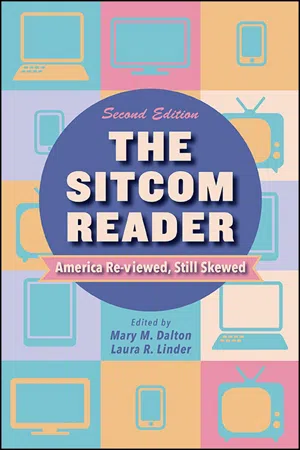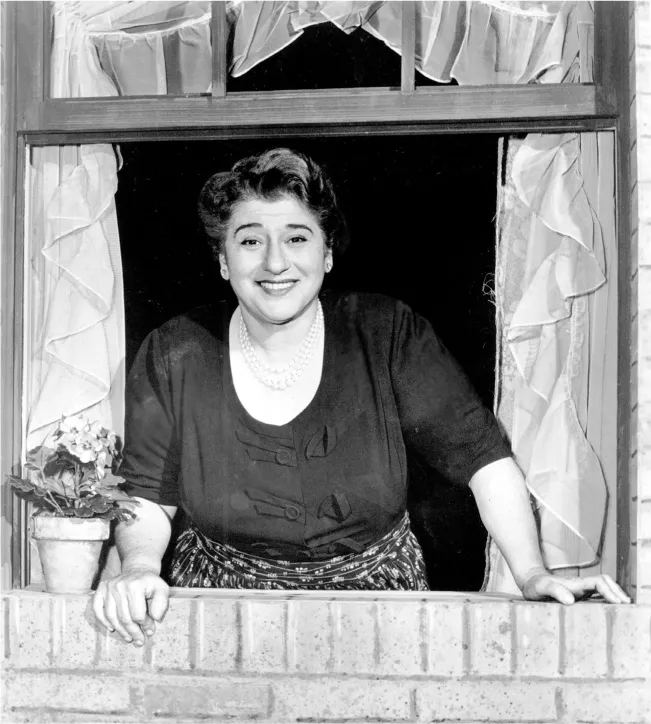![]()
1
Origins of the Genre
In Search of the Radio Sitcom
DAVID MARC
The introduction of a mass communication medium normally occurs when an economically viable commercial application is found for a new technology. A third element necessary to the launch, content (i.e., something to communicate), is often treated as something of an afterthought in this process. As a result, adaptations of popular works and of entire genres from previous media tend to dominate the introductory period, even as they mutate under the developing conditions of the new medium. Such was the case in the rise of the television sitcom from the ashes of network radio.
While a dozen or more long-running network radio series served as sources for early television situation comedies, it is in some ways misleading to describe these radio programs (e.g., Father Knows Best, Amos ’n’ Andy, or The Life of Riley) as “radio sitcoms.” According to the Oxford English Dictionary, neither the term “situation comedy” nor “sitcom” achieved common usage until the 1950s, the point at which this type of entertainment had become completely absent from American radio.
TV Guide appears to be among the first general circulation publications to use the term “situation comedy” in print with the following passage cited by the Oxford English Dictionary from a 1953 article: “Ever since I Love Lucy zoomed to the top rung on the rating ladder, it seems the networks have been filling every available half-hour with another situation comedy” (TV Guide). The abbreviated form, “sitcom,” which probably enjoys greater usage today, has an even shorter history. It is dated in print by the OED only as far back as a 1964 Life magazine article announcing Bing Crosby’s upcoming (and ill-fated) attempt to work in the genre: “Even Bing has succumbed … and will appear in a sitcom as an electrical engineer who happens to break into song once a week” (Life magazine).
The integration of the term “sitcom” into the American language, like much of popular culture, was driven by the promotional needs of the entertainment industry. The Life article cited above provides a case in point. One of the most popular singers in early twentieth-century American show business, Crosby was well known to the public, first through his records and then as a radio personality and movie star. As the star of a radio variety show in the 1930s and 1940s, he demonstrated abilities to deliver gag lines, play the straight man, and trade snappy banter with guests that led to his pairing with Bob Hope in the Paramount “road” pictures.1 While variety programming was as popular on early television as it had been on radio, the genre went into a gradual decline in the 1960s, which eventually led to its virtual absence from prime time.2
With feature film production also in decline during the 1960s, many aging, studio-era movie stars—including Crosby, Donna Reed, Robert Young, Ida Lupino, Fred MacMurray, and Jimmy Stewart—attempted to reinvest their celebrity in situation comedy, a genre that had been experiencing a continuous surge of growth since 1951, when I Love Lucy sprinted past Milton Berle’s Texaco Star Theatre and half a dozen other comedy-variety shows to the top of the prime-time ratings. Furthermore, residual fees from reruns of sitcoms were proving to be an extraordinary cash cow (Schatz).
Though a situation comedy may be accurately described as a “comic drama” or a “narrative comedy” to distinguish it from variety (or comedy-variety) programming, such terms were no doubt considered too eggheaded for promoting the product. Thus, “situation comedy” emerged from its origins in back-office show-biz lingo to become part of popular discourse.3 Its abbreviation to “sitcom” was perhaps all but inevitable in accordance with the grammar of public relations.
DIALECT COMEDIES
Two of the longest-running and most popular “radio sitcoms” to be adapted for television were The Goldbergs (premiering on the NBC radio network in 1929 as The Rise of the Goldbergs) and Amos ’n’ Andy (premiering locally in Chicago in 1928 and going national on NBC the following year). Both series began as live 15-minute programs that aired Monday through Friday, a broadcast format more akin to radio soap opera than television sitcom, and both were restructured into weekly half-hour series during the early 1940s. Both were adapted for television early in the life of the medium (The Goldbergs in 1949; Amos ’n’ Andy in 1951) as weekly, half-hour, filmed series with audience response tracks, all characteristics that became basic to the genre. The two programs shared significant content attributes as well. Both made primary use of ethnic dialect comedy, a source of popular humor traceable in American culture to the nineteenth-century minstrel and vaudeville stages.4
The Goldbergs was written and produced on both radio and television by its star, Gertrude Berg, one of only a very few women who produced their own network programs.5 The thick Ashkenazic (i.e., eastern European) Jewish accents of the program’s immigrant generation characters provided much of the show’s humor while the younger, born-in-America characters spoke something more akin to standard radio English, sporadically adding inflections to acknowledge the series’ Bronx location. Plotting was generally based on the exploitation of character stereotypes, especially live-in Uncle David’s failure to catch the gist of things American (in one episode we learn that he has named his goldfish “Karl Marx” because of his respect for philosophers). But, despite its reliance on stereotyping, The Goldbergs could rarely be accused of anything more noxious than a kind of chicken-soup sentimentality in its content.
Amos ’n’ Andy, centered on African American characters living in Harlem, was written, produced, and performed on radio by Freeman Gosden and Charles Correll, Whites who had grown up in the Jim Crow South. The pair had performed blackface “race humor” onstage in vaudeville and had done stints with several of the surviving minstrel shows of the early twentieth century. Their Amos ’n’ Andy radio series—loosely based on “Sam and Henry,” two earlier characters they had created—grew from a local program on WMAQ-Chicago to what was arguably the most listened to prime-time entertainment series in the history of radio.6
When the television adaptation of Amos ’n’ Andy came under attack by the NAACP and other civic organizations following its 1951 premiere, Gosden and Correll claimed to be nonplussed, even hurt, by claims made about the show’s perpetuation of negative stereotypes. They argued that they were performing the same type of dialect humor in their depiction of “Negroes” as other sitcoms used in their comic depictions of any number of ethnic groups (The Goldbergs’ Jewish characters being a prime example; I Love Lucy’s Hispanic character, Ricky Ricardo, being another). In viewing Amos ’n’ Andy today, it is difficult to ignore the series’ unrelenting focus on negative stereotypes derived from the slavery era. The level of stupidity that emerges from the relentless use of farfetched malapropisms makes it difficult to characterize the effect of the sitcom as anything but racist at its core (Cripps 33–54).
Figure 1.1. Spencer Williams, Jr. as Andy Brown, Tim Moore as George “The Kingfish” Stevens, and Alvin Childress as Amos Jones in Amos ’n’ Andy. 1951–1953. Photo courtesy of Movie Star NewsFair.
The efforts of civil rights organizations to pressure CBS into canceling Amos ’n’ Andy in 1953, despite the program’s bankable Nielsen ratings, is counted by some as among the first battles won in the post-World War II Civil Rights Movement. If there is tragedy in the incident, it fell upon the African American performers. Gosden and Correll, who had performed as the title characters in three feature films for MGM, were dissuaded from taking on the roles in the television series and had replaced themselves and others in the cast with African American actors.7 As these performers had predicted in arguing for the continuation of the show, the cancellation left them without any role to play in “all-White” television.8 An ensemble of masterful African American comedians, including Tim Moore (as The Kingfish), Ernestine Wade (as Sapphire), and Johnny Lee (as Algonquin J. Calhoun), simply disappeared from public view. Amanda Randolph (Mama), Kingfish’s hilarious “battle ax” mother-in-law, was the sole exception. She took the part of the family maid on The Danny Thomas Show.9
Sitting atop the radio ratings with audiences numbering in the tens of millions, comedies such as The Goldbergs and Amos ’n’ Andy seemed obvious choices for television, as were other radio hits that depended heavily on dialect humor. These included Life with Luigi (Italians in Chicago); I Remember Mama (Norwegians in San Francisco); and Beulah (African American servants in Middle American suburbia).10 While dialect humor was a natural for an aural medium, what had had been a staple on radio proved to be a short-lived phenomenon on television and a poor fit for the emerging culture of postwar America.
The ethnic sitcoms suffered from the popular promotion of assimilationism that accompanied the mass migration of immigrant and second-generation White families from inner-city neighborhoods to suburban tracts. The exaggerated accents and malapropisms of radio comedy might have become more embarrassing than funny to a significant segment of the early television-viewing audience, which was located almost exclusively in large metropolitan areas.11 Thomas Cripps has suggested that African American war veterans played a significant role in opposing the television adaptation of Amos ’n’ Andy, which they saw as an instrument for perpetuation of the longstanding stereotypes that stood behind Jim Crow laws.
Though it had run for two decades on radio, Amos ’n’ Andy was gone from television in two seasons. The Goldbergs managed to remain on the air for six seasons, but this was largely due to Gertrude Berg’s savvy as a producer. She repeatedly made new deals to save the show, switching television networks three times and even agreeing to change the 25-year-old format by moving the family from the Bronx to the suburbs and renaming the sitcom Molly. In the end, ridding the show of what was now seen as its Depression-era, immigrant baggage left it a limp imitation of itself. Following Molly’s cancellation in 1955, not a single radio dialect comedy was left on the air. Suburban families with names such as Stone (The Donna Reed Show) and Anderson (Father Knows Best) moved in to dominate the genre.
Figure 1.2 Gertrude Berg as Molly Goldberg in The Goldbergs. 1929–1954 (radio 1929–1948 & television 1949–1954). Photo courtesy of Photofest.
THE SITCOM-VARIETY SHOW HYBRIDS
Like The Goldbergs and Amos ’n’ Andy, The Jack Benny Program and The George Burns and Gracie Allen Show were among radio’s most popular hits. These shows present complex genre problems when considered as sources for the television programs of the same name. On radio, Benny and Burns and Allen made frequent use of seamless aural segués to shift rhetorical modes between direct-address presentation (i.e., the vaudeville-derived variety format) and representational narratives of domestic life that seem very much like radio prototypes of contemporary television sitcoms.12 Genre theory has thus far been unable to account for these shows in any satisfying way, and so they are treated as “radio sitcoms” by a kind of critical default.13
The purposeful confusion of the two principal genres of broadcast comedy (sitcom and variety), which radio accomplished by a mere shift of language, required much more work for presentation on television. I Love Lucy and The Adventures of Ozzie and Harriet, two sitcoms featuring bandleaders as husband-fathers, made use o...


